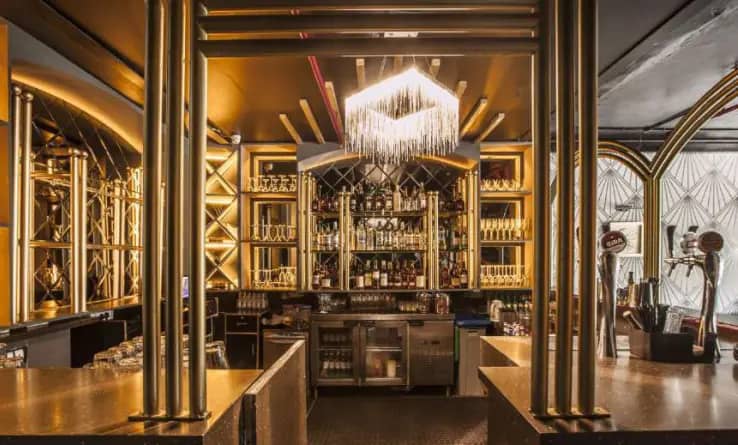
How to Create a Unique Brand Identity Through Restaurant Interior Design?
Restaurant branding is a crucial aspect of the food industry, as it can make or break the success of a business. A strong brand identity sets a restaurant apart from the competition and establishes a unique image in the minds of customers. This image can influence customer loyalty, perception of quality, and ultimately, the restaurant’s success. In this article, we will explore the importance of restaurant branding and how to create an effective brand strategy.
Read Our Blog On 9 Innovative Office Interiors Designs Idea For Your Office
Why is restaurant branding important?
Restaurant Branding is essential in the food industry because customers make dining decisions based on the reputation and image of a restaurant. A strong brand can differentiate a restaurant from its competitors and create a sense of trust and familiarity among customers. This trust can lead to increased customer loyalty, which is important in an industry where customer loyalty can mean the difference between success and failure.
Additionally, branding can influence customer perception of the quality of food and service offered by a restaurant. A well-established brand can make customers feel more confident in their dining decision, leading to increased repeat business and positive word-of-mouth marketing.
How to create an effective brand strategy
Define your brand identity: The first step in creating an effective brand strategy is to define your brand identity. This includes identifying your target audience, your unique selling proposition, and your brand personality.
Establish a consistent visual identity: Your visual identity should be consistent across all branding materials, including your logo, signage, menus, and website. This consistency reinforces your brand identity and helps customers easily recognize your restaurant.
Create a clear brand message: Your brand message should communicate your unique selling proposition and the benefits of dining at your restaurant. This message should be consistent across all communication channels, including your website, social media, and advertising.
Use social media effectively: Social media is a powerful tool for building brand awareness and connecting with customers. Use social media to share photos and videos of your food, updates on menu changes, and special promotions.
Focus on customer experience: Your brand should reflect the overall customer experience, from the quality of food to the service provided by your staff. A positive customer experience can lead to increased customer loyalty and positive word-of-mouth marketing.
In this article, we will explore the various elements that make up a successful restaurant interior design, and how to use them to create a unique brand identity.
Define Your Brand’s Personality
Before embarking on a restaurant interior design project, it’s important to define the personality of your brand. This includes considering factors such as the type of cuisine you serve, your target audience, and the overall atmosphere you want to create. The Restaurant interior design should reflect the personality of your brand and help to communicate your message to customers.
For example, if you are serving upscale cuisine in a fine dining setting, you might want to create a sophisticated and elegant atmosphere. On the other hand, if you are targeting a younger, hip crowd with a casual eatery, a more laid-back and fun atmosphere might be more appropriate.
Choose a Color Scheme that Reflects Your Brand
Color plays a crucial role in setting the tone and mood of a restaurant. The right color scheme can help to create a unique and memorable brand identity. When selecting a color scheme, consider your brand’s personality and the message you want to convey to customers.
For example, if you want to create a warm and inviting atmosphere, consider using warm, earthy tones such as orange, brown, and yellow. If you want to create a cool and sophisticated atmosphere, consider using cool, calming tones such as blue, green, and gray.
Incorporate Branding Elements into the Design
One of the most effective ways to establish a unique brand identity is to incorporate branding elements into the design. This can include things like logos, slogans, and unique design elements that are specific to your brand.
For example, if you have a specific logo for your restaurant, consider incorporating it into the design in a prominent location, such as a wall mural or backlit sign. This will help to create a visual association between your brand and the interior design, making it easier for customers to recognize and remember your restaurant.
Use Textures and Materials to Create a Unique Atmosphere
The textures and materials used in a restaurant interior design can have a big impact on the overall atmosphere. For example, using rough, natural materials like brick or stone can create a rustic, earthy feel, while using smooth, polished materials like marble or glass can create a modern, sophisticated atmosphere.
When selecting textures and materials, consider the personality of your brand and the message you want to convey. For example, if your brand is all about luxury and sophistication, consider using high-end materials such as marble, leather, and glass.
Incorporate Unique Design Features
Unique design features can help to make your restaurant interior stand out and create a memorable brand identity. These can include things like custom lighting fixtures, unique wall coverings, and statement pieces of furniture.
For example, if your brand is all about sustainability and eco-friendliness, consider incorporating features such as live green walls or recycled materials into the design. This will not only help to create a unique brand identity, but also demonstrate your commitment to environmental responsibility to customers.
In conclusion, restaurant branding is an essential aspect of the food industry. A strong brand identity can differentiate a restaurant from its competitors, influence customer perception of quality, and ultimately, contribute to the success of a business. By following the steps outlined in this article, restaurant owners can create an effective brand strategy and build a strong, recognizable brand in the minds of their customers.


0 comments